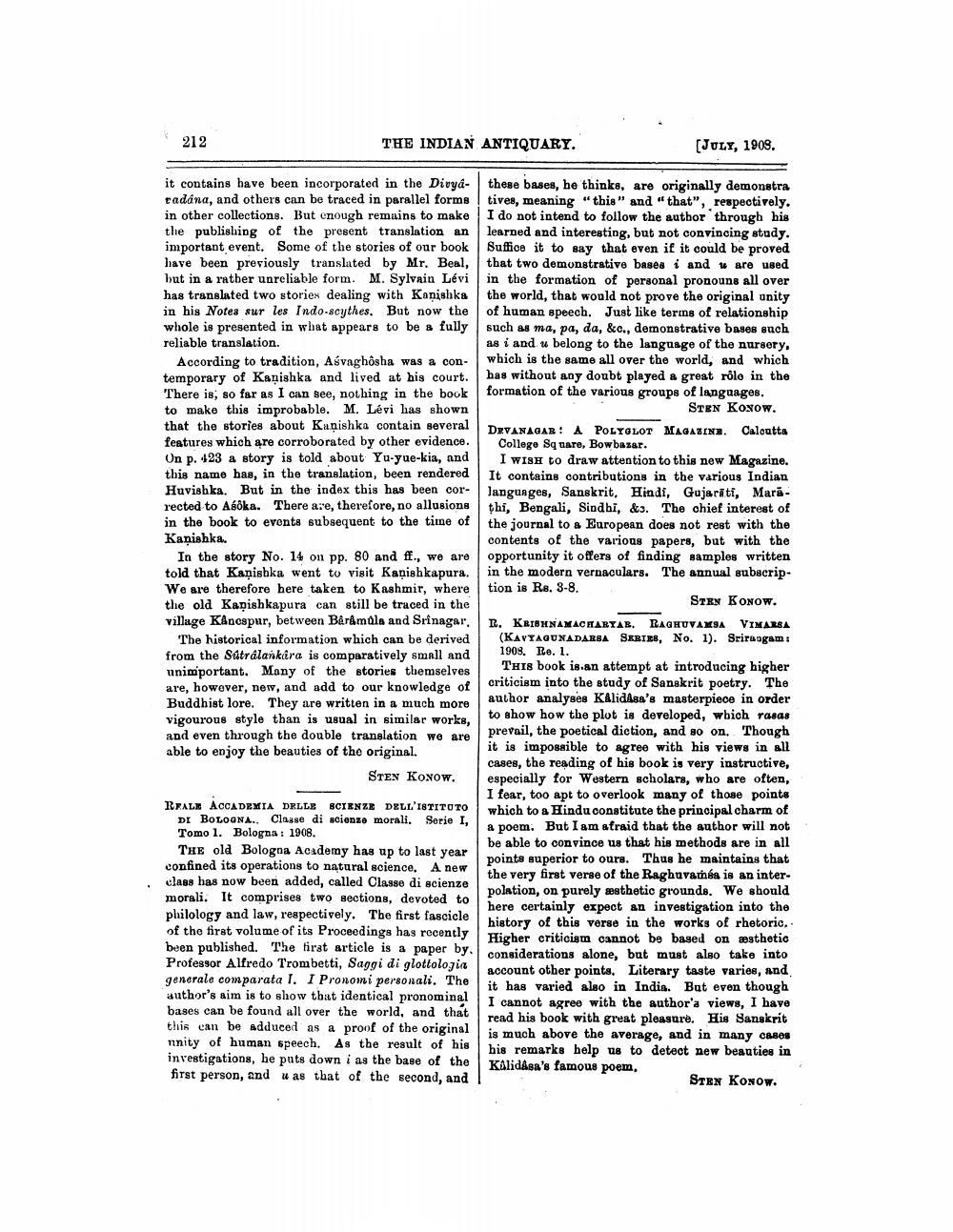________________
212
THE INDIAN ANTIQUARY.
(JULY, 1908.
it contains have been incorporated in the Divya- these bases, he thinks, are originally demonstra cadana, and others can be traced in parallel forms tives, meaning "this" and "that", respectively. in other collections. But enough remains to make I do not intend to follow the author through his the publishing of the present translation an learned and interesting, but not convincing study. important event. Some of the stories of our book Suffice it to say that even if it could be proved have been previously translated by Mr. Beal, that two demonstrative bases i and ware used but in a rather unreliable form. M. Sylvain Lévi in the formation of personal pronouns all over has translated two stories dealing with Kanishka the world, that would not prove the original unity in his Notes sur les Indo-scythes. But now the of human speech. Just like terms of relationship whole is presented in what appears to be a fully such as ma, pa, da, &c., demonstrative bases such reliable translation.
as i and 4 belong to the language of the nursery. According to tradition, Ašvaghôsha was a con- which is the same all over the world, and which temporary of Kanishka and lived at his court. has without any doubt played a great rólo in the There is so far as I can see, nothing in the book formation of the various groups of languages. to make this improbable. M. Levi has shown
STEN Koxow. that the stories about Kanishka contain several
DEVANAGAR: A POLYGLOT MAGAZINE. Caloutta features which are corroborated by other evidence. | College Square, Bowbazar. On p. 423 a story is told about Yu-yue-kia, and I WISH to draw attention to this new Magazine.
I WISH to draw attenta this name has, in the translation, been rendered It contains contributions in the various Indian Huvishka. But in the index this has been cor- languages, Sanskrit, Hindi, Gujarati, Mara - rected to Aboka. There are, therefore, no allusions thi, Bengali, Sindhi, &s. The chief interest of in the book to events subsequent to the time of
the journal to a European does not rest with the Kanishka.
contents of the various papers, but with the In the story No. 14 on pp. 80 and ff., we are opportunity it offers of finding samples written told that Kanishka went to visit Kanishkapura. in the modern vernaculars. The annual subscrip. We are therefore here taken to Kashmir, where tion is Rs. 3-8. the old Kanishkapura can still be traced in the
STEN KONow. village Kancspur, between Bêrêmala and Srinagar, 1. KRISHNAMACHARYAR. RAGHUVAXSA VIMARA
The historical information which can be derived (KAVYAGUNADARSA SERIEB, No. 1). Srirangam : from the Satralankara is comparatively small and
1908. Re. 1. unimportant. Many of the stories themselves
This book is an attempt at introducing higher are, however, new, and add to our knowledge of
criticism into the study of Sanskrit poetry. The Buddhist lore. They are written in a much more
author analyses KAlidasa's masterpiece in order vigourous style than is usual in similar works,
to show how the plot is developed, wbich rasas and even through the double translation we are
prevail, the poetical diction, and so on. Though
it is impossible to agree with his views in all able to enjoy the beauties of the original.
cases, the reading of his book is very instructive, STEN Konow. especially for Western scholars, who are often,
I fear, too apt to overlook many of those points REALE ACCADEMIA DRLLE SCIENZE DELL'ISTITOTO
which to a Hindu constitute the principal charm of DE BOLOGNA. Classe di scienzo morali. Serie I,
a poem. But I am straid that the author will not Tomo 1. Bologna: 1908.
be able to convince us that his methods are in all THE old Bologna Academy has up to last year
points superior to ours. Thus he maintains that confined its operations to natural science. A new
the very first verse of the Raghuvatás is an interclass has now been added, called Classe di scienze
polation, on purely esthetic grounds. We should morali. It comprises two sections, devoted to
here certainly expect an investigation into the philology and law, respectively. The first fascicle history of this verse in the works of rhetoric. of the first volume of its Proceedings has recently Higher criticism cannot be based on wsthetic been published. The first article is a paper by. I considerations alone, but must also take into Professor Alfredo Trombetti, Saggi di glottologin
account other points. Literary taste varies, and generale comparata I. I Pronomi personali. The
it has varied also in India. But even though author's aim is to show that identical pronominal
I cannot agree with the author'a views, I have bases can be found all over the world, and that
read his book with great pleasure. His Sanskrit this can be adduced as a proof of the original
is much above the average, and in many casos unity of human speech. As the result of his
his remarks belp us to detect new beauties in investigations, he puts down i as the base of the Kalidasa's famous poem, first person, and was that of the second, and
STEN KONow.




